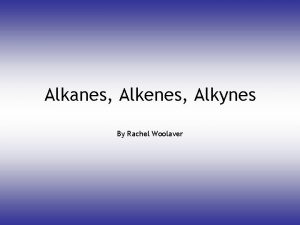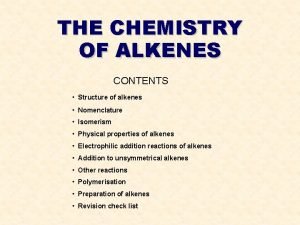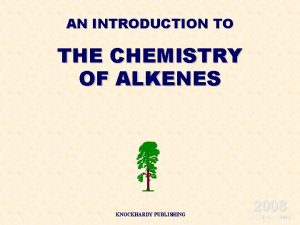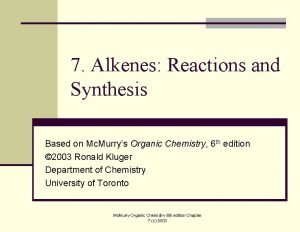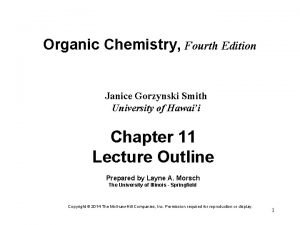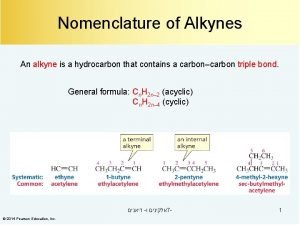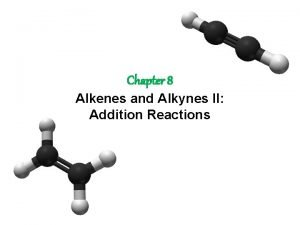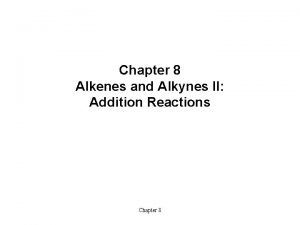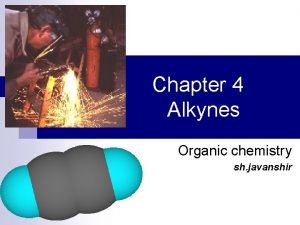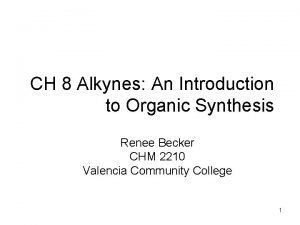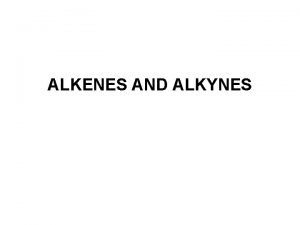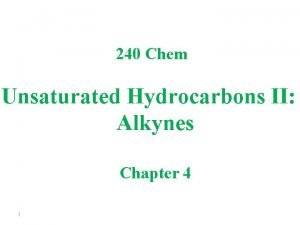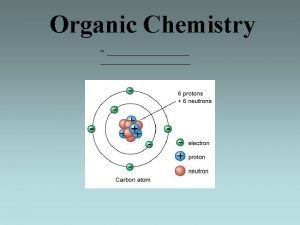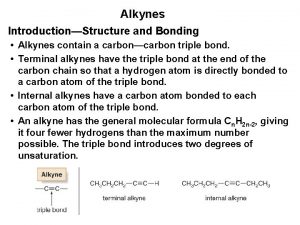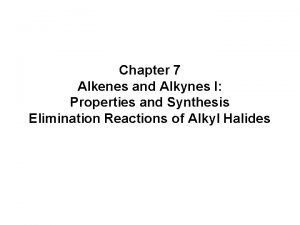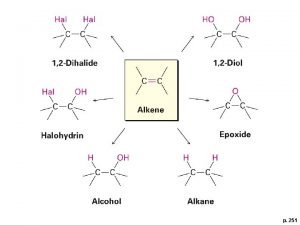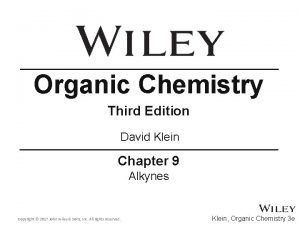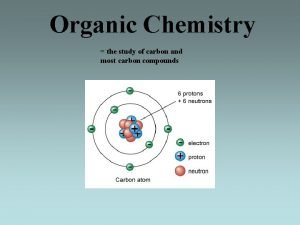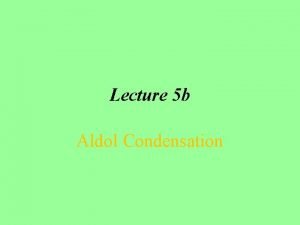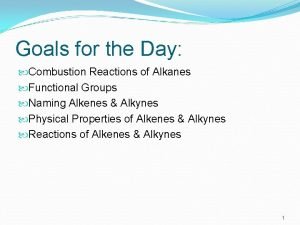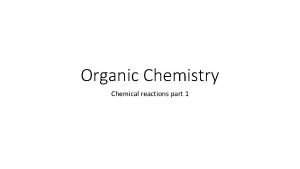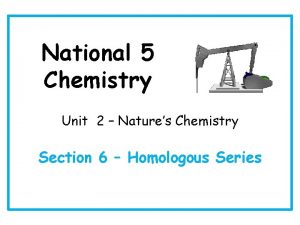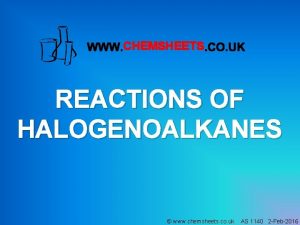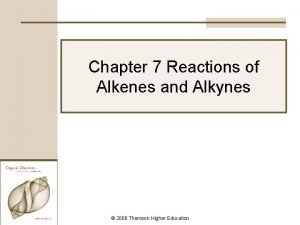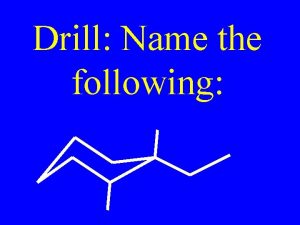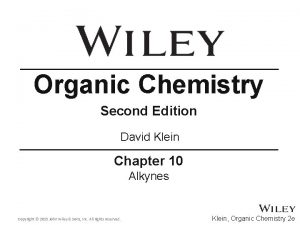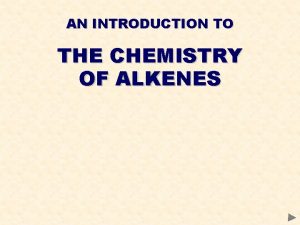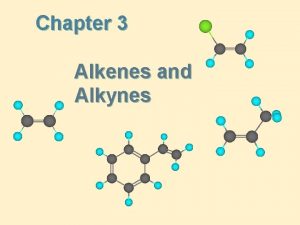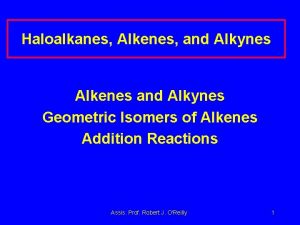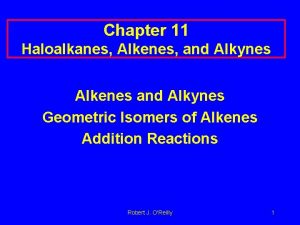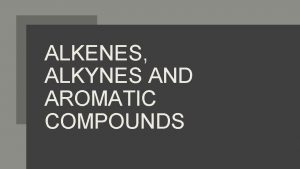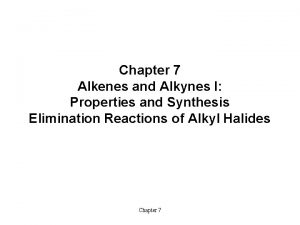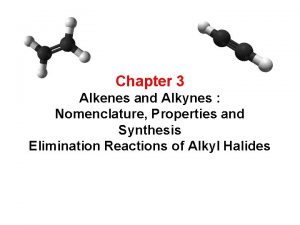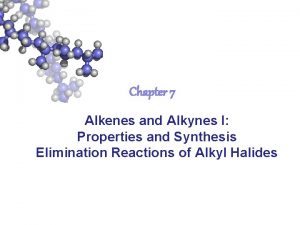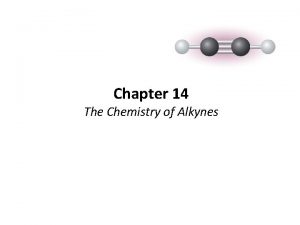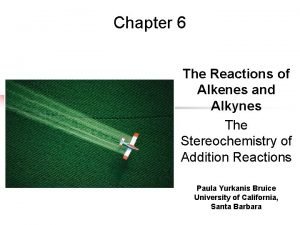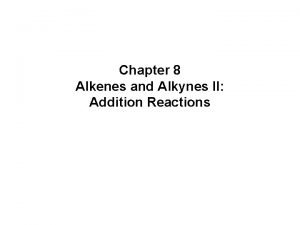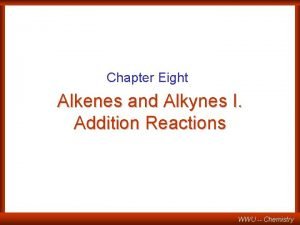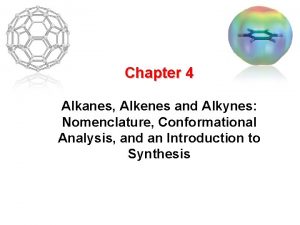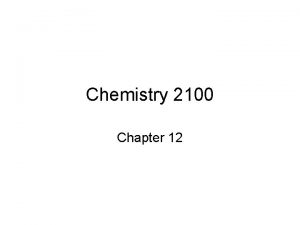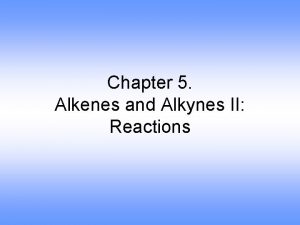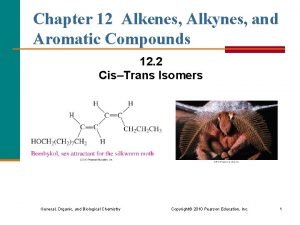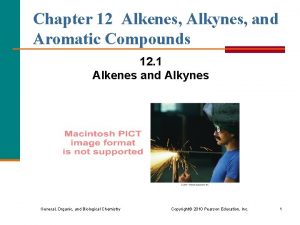Chapter 5 Alkenes and Alkynes I Properties and


































- Slides: 34

Chapter 5 Alkenes and Alkynes I: アルケン類、アルキン類 Properties and Synthesis Elimination Reactions of Alkyl Halides Chapter 7

t The (E)-(Z) System for Designating Alkene Diastereomers èThe Cahn-Ingold-Prelog convention is used to assign the groups of highest priority on each carbon If the group of highest priority on one carbon is on the same side as the group of highest priority on the other carbon the double bond is Z (zusammen) H If the highest priority groups are on opposite sides the alkene is E (entgegen) H Chapter 7 2

t Relative Stabilities of Alkenes èGenerally cis alkenes are less stable than trans alkenes because of steric hinderance l Heat of Hydrogenation èThe relative stabilities of alkenes can be measured using the exothermic heats of hydrogenation Chapter 7 3

èHeats of hydrogenation of three butene isomers: l Overall Relative Stabilities of Alkenes èThe greater the number of attached alkyl groups (i. e. the more highly substituted the carbon atoms of the double bond), the greater the alkene’s stability Chapter 7 4

t Synthesis of Alkenes via Elimination Reactions Dehydrohalogenation(脱ハロゲン化水素) èReactions by an E 2 mechanism are most useful H E 1 reactions can be problematic èE 2 reaction are favored by: H Secondary or tertiary alkyl halides H Alkoxide bases such as sodium ethoxide or potassium tertbutoxide èBulky bases such as potassium tert-butoxide should be used for E 2 reactions of primary alkyl halides Chapter 7 5

l Zaitsev’s Rule(ザイツェッフ則): l Formation of the Most Substituted Alkene is Favored with a Small Base Q:どちらが主生成物か? Chapter 7 6

l Zaitzev’s Rule: when two different alkene products are possible in an elimination, the most highly substituted (most stable) alkene will be the major product H This is true only if a small base such as ethoxide is used Chapter 7 7

èThe transition state in this E 2 reaction has double bond character èThe trisubstituted alkene-like transition state will be most stable and have the lowest DG‡ èKinetic control of product formation(反応速度支配): When one of two products is formed because its free energy of activation is lower and therefore the rate of its formation is higher Chapter 7 8

l Formation of the Least Substituted Alkene Using a Bulky Base èBulky bases such as potassium tert-butoxide have difficulty removing sterically hindered hydrogens and generally only react with more accessible hydrogens (e. g. primary hydrogens) Bulky base Chapter 7 9

t Acid Catalyzed Dehydration of Alcohols(脱水反応) èRecall that elimination is favored over substitution at higher temperatures èTypical acids used in dehydration are sulfuric acid and phosphoric acid èThe temperature and concentration of acid required to dehydrate depends on the structure of the alcohol H Primary alcohols are most difficult to dehydrate, tertiary are the easiest èRearrangements of the carbon skeleton can occur Chapter 7 10

l Mechanism for Dehydration of Secondary and Tertiary Alcohols: An E 1 Reaction èOnly a catalytic amount of acid is required since it is regenerated in the final step of the reaction Chapter 7 11

Chapter 7 12

l Carbocation Stability and the Transition State èRecall the stability of carbocations is: è The second step of the E 1 mechanism in which the carbocation forms is rate determining èThe transition state for this reaction has carbocation character èTertiary alcohols react the fastest because they have the most stable tertiary carbocation-like transition state in the Chapter 7 13 second step

èThe relative heights of DG‡ for the second step of E 1 dehydration Chapter 7 14

l A Mechanism for Dehydration of Primary Alcohols: An E 2 Reaction èPrimary alcohols cannot undergo E 1 dehydration because of the instability of the carbocation-like transition state in the 2 nd step Step 1 Step 2 Chapter 7 15

t Carbocation Stability and the Occurrence of Molecular Rearrangements(分子転位) l Rearrangements During Dehydration of Secondary Alcohols èRearrangements of carbocations occur if a more stable carbocation can be obtained èExample èThe first two steps are to same as for any E 1 dehydration Chapter 7 16

èIn the third step the less stable 2 o carbocation rearranges by shift of a methyl group with its electrons (a methanide) H This is called a 1, 2 shift Chapter 7 17

èThe removal of a proton to form the alkene occurs to give the Zaitzev (most substituted) product as the major one Chapter 7 18


t Synthesis of Alkynes by Elimination Reactions èAlkynes can be obtained by two consecutive dehydrohalogenation reactions of a vicinal dihalide Chapter 7 20

èAlkenes can be converted to alkynes by bromination and two consecutive dehydrohalogenation reactions èGeminal dihalides can also undergo consecutive dehydrohalogenation reactions to yield the alkyne Chapter 7 21

t The Acidity of Terminal Alkynes èRecall that acetylenic hydrogens have a p. Ka of about 25 and are much more acidic than most other C-H bonds èThe relative acidity of acetylenic hydrogens in solution is: èAcetylenic hydrogens can be deprotonated with relatively strong bases (sodium amide is typical) H The products are called alkynides Chapter 7 22

t Replacement of the Acetylenic Hydrogen Atom of Terminal Alkynes èSodium alkynides can be used as nucleophiles in SN 2 reactions H New carbon-carbon bonds are the result H Only primary alkyl halides can be used or else elimination reactions predominate Chapter 7 23

Hydrogenation (水素化、水素還元、接触還元) Chapter 7 24

t Hydrogenation of Alkenes èHydrogen adds to alkenes in the presence of metal catalysts èHeterogeneous catalysts: finely divided insoluble platinum, palladium or nickel catalysts èHomogeneous catalysts: catalyst(typically rhodium or ruthenium based) is soluble in the reaction medium H Wilkinson’s catalyst is Rh[(C 6 H 5)3 P]3 Cl èThis process is called a reduction or hydrogenation Chapter 7 25

t Hydrogenation: The Function of the Catalyst èThe catalyst provides a new reaction pathway with lower DG‡ values Chapter 7 26

èIn heterogeneous catalysis the hydrogen and alkene adsorb to the catalyst surface and then a step-wise formation of C-H bonds occurs èBoth hydrogens add to the same face of the alkene (a syn addition) H Addition to opposite faces of the double bond is called anti addition Chapter 7 27

t Hydrogenation of Alkynes èReaction of hydrogen using regular metal catalysts results in formation of the alkane l Syn Addition of Hydrogen: Synthesis of cis-Alkenes èThe P-2 catalyst nickel boride results in syn addition of one equivalent of hydrogen to a triple bond èAn internal alkyne will yield a cis double bond Chapter 7 28

èLindlar’s catalyst also produces cis-alkenes from alkynes l Anti Addition of Hydrogen: Synthesis of trans-Alkenes èA dissolving metal reaction which uses lithium or sodium metal in low temperature ammonia or amine solvent produces trans-alkenes èNet anti addition occurs by formal addition of hydrogen to the opposite faces of the double bond Chapter 7 29

èThe mechanism is a free radical reaction with two electron transfer reactions from the metal èThe vinylic anion prefers to be trans and this determines the trans stereochemistry of the product Chapter 7 30

Index of Hydrogen Deficiency (IHD) (水素欠損係数 不飽和度) Chapter 7 31

t Structural Information from Molecular Formulas and the Index of Hydrogen Deficiency (IHD) l Unsaturated and Cyclic Compounds èA compound with the general molecular formula Cn. H 2 n will have either a double bond or a ring èA compound with general formula Cn. H 2 n-2 can have a triple bond, two double bonds, a double bond a ring or two rings èIndex of Hydrogen Deficiency: the number of pairs of hydrogen atoms that must be subtracted from the molecular formula of the corresponding alkane to give the molecular formula of the compound under consideration Chapter 7 32

èExample: A compound with molecular formula C 6 H 12 èHydrogenation allows one to distinguish a compound with a double bond from one with a ring l Compounds Containing Halogens, Oxygen, or Nitrogen èFor compounds containing halogen atoms, the halogen atoms are counted as if they were hydrogen atoms èExample: A compound with formula C 4 H 6 Cl 2 H This is equivalent to a compound with molecular formula C 4 H 8 which has IHD=1 Chapter 7 33

èFor compounds containing oxygen, the oxygen is ignored and IHD is calculated based on the rest of the formula H Example: A compound with formula C 4 H 8 O has IHD = 1 èFor compounds containing nitrogen, one hydrogen is subtracted for each nitrogen and the nitrogen is ignored in the calculation H Example: A compound with formula C 4 H 9 N is treated as if it has formula C 4 H 8 and has IHD = 1 Chapter 7 34
 Alkanes alkenes alkynes
Alkanes alkenes alkynes Bromine test for unsaturation
Bromine test for unsaturation Properties of alkenes
Properties of alkenes Alkenes reactions and synthesis
Alkenes reactions and synthesis Halogenation of alkynes
Halogenation of alkynes Lindlar pd
Lindlar pd Mechanism of ozonolysis
Mechanism of ozonolysis Is acid catalyzed hydration syn or anti
Is acid catalyzed hydration syn or anti Mercury catalyzed hydration of alkynes
Mercury catalyzed hydration of alkynes Mercury catalyzed hydration of alkynes
Mercury catalyzed hydration of alkynes General molecular formula of alkene
General molecular formula of alkene Ozonolysis of alkynes
Ozonolysis of alkynes What are the first 10 alkynes
What are the first 10 alkynes Preparation of alkynes
Preparation of alkynes Alkynes
Alkynes Alkynes
Alkynes Alkyne reactions
Alkyne reactions First 10 members of alkynes
First 10 members of alkynes Aldol condensation
Aldol condensation Combustion of alkynes
Combustion of alkynes Incomplete combustion of propene
Incomplete combustion of propene General molecular formula of alkene
General molecular formula of alkene Chemsheets halogenoalkanes
Chemsheets halogenoalkanes Hobr addition to alkene
Hobr addition to alkene Sp2 hybridization in alkenes
Sp2 hybridization in alkenes Name the following alkene:
Name the following alkene: Naming alkenes
Naming alkenes Test for alkenes
Test for alkenes But-1-ene to but-2-ene
But-1-ene to but-2-ene E or z configuration
E or z configuration Alkenes introduction
Alkenes introduction Extensive and intensive properties
Extensive and intensive properties Physical and chemical properties
Physical and chemical properties Identify m∠efh.
Identify m∠efh. Chapter 11 properties of the hair and scalp answers
Chapter 11 properties of the hair and scalp answers
